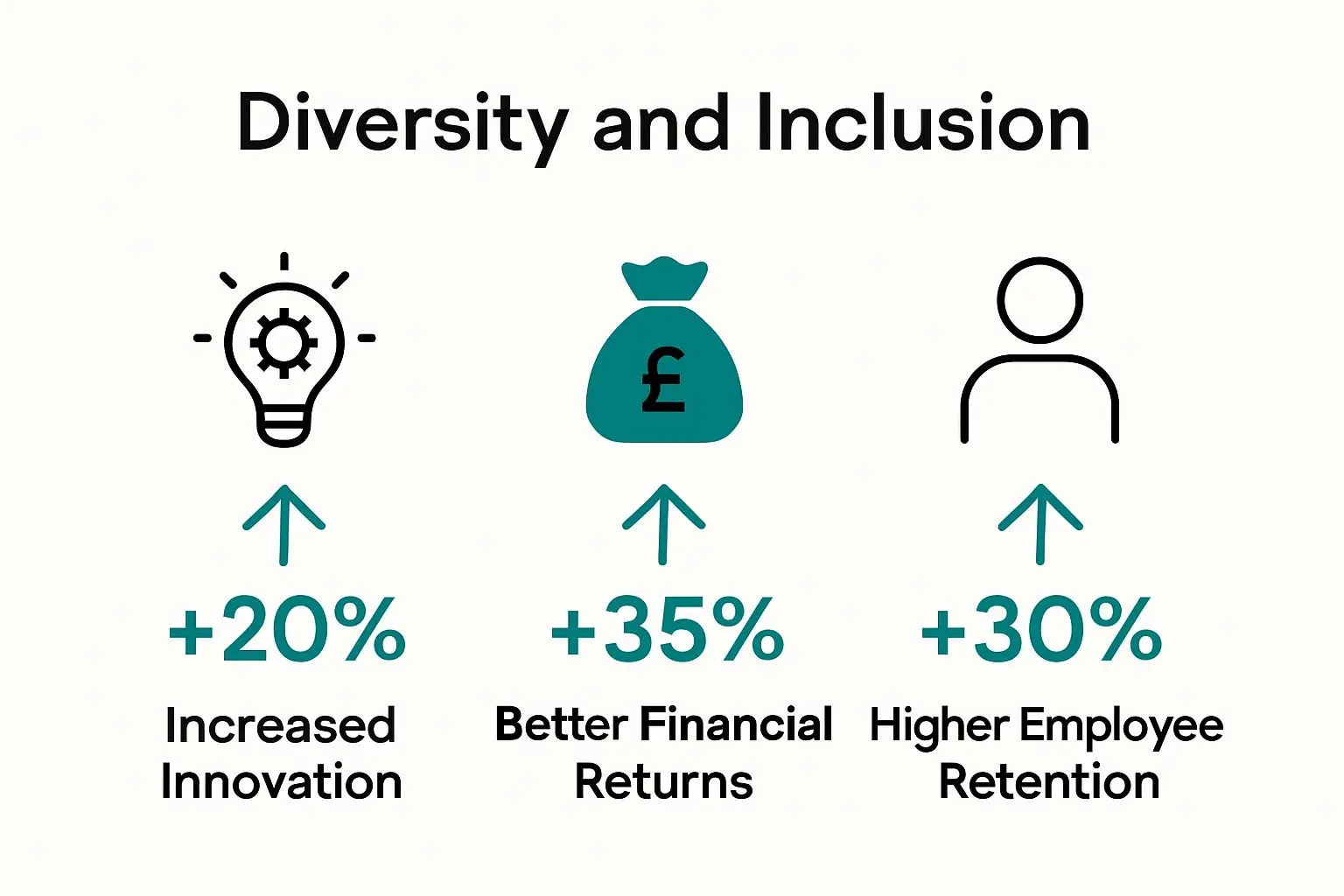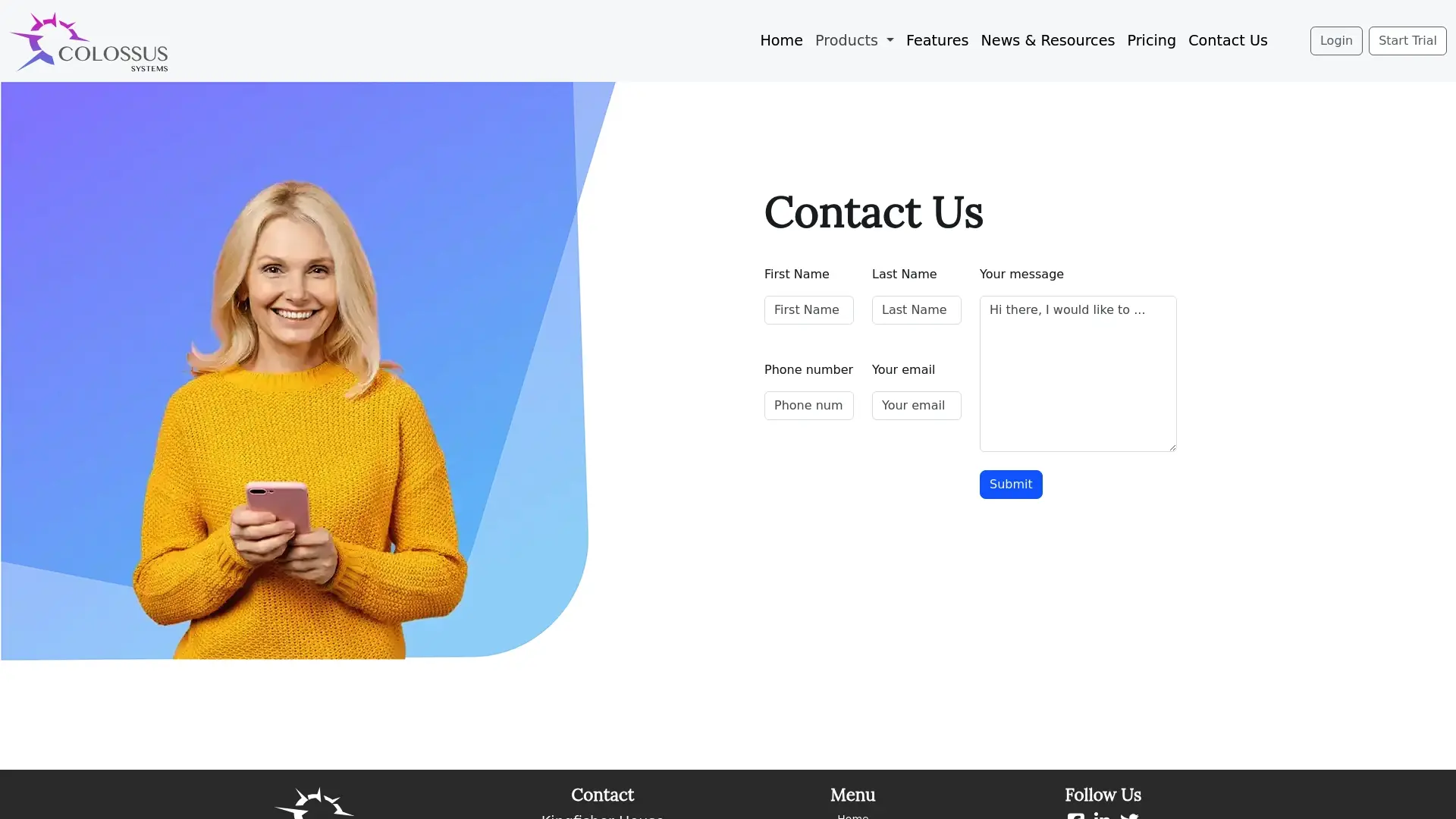Understanding Diversity and Inclusion Strategies Effectively

Diversity and inclusion strategies are changing the way organisations think about the workplace. It may sound surprising, but companies with the highest diversity are 35 percent more likely to achieve above average financial returns. Most people expect these efforts to be about compliance or charity. Instead, true diversity strategies are becoming the sharpest edge in business success and innovation.
Table of Contents
- What Are Diversity And Inclusion Strategies?
- Why Diversity And Inclusion Truly Matter
- Key Concepts Driving Effective Strategies
- Real-World Examples Of Successful Implementation
Quick Summary
| Takeaway | Explanation |
|---|---|
| Diversity fosters innovation and performance | Diverse teams enhance problem-solving and decision-making, leading to improved financial outcomes and innovation capabilities. |
| Incorporate accountability in diversity initiatives | Establish clear responsibilities to ensure commitment to diversity and inclusion, promoting sustained organisational change. |
| Continuous learning is key to inclusion success | Ongoing training and adaptation are necessary to overcome systemic barriers and cultivate an inclusive culture. |
| Employee resource groups support inclusivity | Creating groups for diverse employees fosters a sense of belonging and provides mentorship and networking opportunities. |
| Measure progress with diverse metrics | Use quantitative and qualitative assessments to evaluate the effectiveness of diversity strategies and inform necessary adjustments. |
What are Diversity and Inclusion Strategies?
Diversity and inclusion strategies are comprehensive organizational approaches designed to create workplace environments that actively embrace and support individuals from varied backgrounds, perspectives, and identities. These strategies go beyond mere compliance with legal requirements, representing a proactive commitment to building cultures of genuine respect, equity, and belonging.
The following table summarises core components commonly found in effective diversity and inclusion strategies, along with a concise explanation of each element for organisational understanding.
| Component | Description |
|---|---|
| Recruitment for Diverse Talent | Attracting candidates from varied backgrounds and experiences |
| Inclusive Leadership Development | Training leaders to foster and support inclusivity |
| Anti-discrimination Policies | Implementing formal measures to prevent bias and unfair treatment |
| Equitable Performance Evaluation | Standardising assessment to ensure fairness across all employees |
| Cultural Competency Training | Educating staff to understand and respect cultural differences |
Foundational Components of Diversity and Inclusion
At their core, diversity and inclusion strategies encompass systematic methods to address potential barriers and create opportunities for all employees. Organizational research indicates these strategies typically involve multiple interconnected elements:
- Recruitment practices that deliberately seek diverse talent
- Inclusive leadership development programs
- Structured anti discrimination policies
- Equitable performance evaluation processes
- Cultural competency training initiatives
Strategic Implementation Approaches
Successful diversity and inclusion strategies require deliberate, multifaceted approaches. Organizations must move beyond tokenistic representation to create substantive cultural transformation.
This involves understanding systemic barriers, developing targeted interventions, and measuring meaningful progress through quantitative and qualitative metrics.
Key implementation strategies include:
- Establishing clear accountability mechanisms
- Developing comprehensive mentorship programs
- Creating employee resource groups
- Conducting regular diversity climate assessments
- Implementing transparent promotion pathways
While implementing these strategies, organizations must recognize that diversity and inclusion are ongoing processes requiring continuous learning, adaptation, and commitment. Learn more about developing organizational leadership strategies that support inclusive workplace cultures.
Why Diversity and Inclusion Truly Matter
Diversity and inclusion are not just ethical imperatives but strategic business advantages that drive innovation, enhance organizational performance, and create more dynamic, resilient workplaces. By embracing diverse perspectives and creating genuinely inclusive environments, organizations can unlock significant potential across multiple dimensions of success.
This table presents the economic, performance, and social advantages linked to effective diversity and inclusion, highlighting both business outcomes and wider societal impacts.
| Advantage Type | Example Benefit |
|---|---|
| Economic/Performance | Enhanced innovation and market understanding |
| Economic/Performance | Better decision making and problem-solving |
| Economic/Performance | Improved financial returns (35% likelihood of above-average returns) |
| Social/Ethical | Promotion of social mobility |
| Social/Ethical | Creation of more equitable professional environments |
| Social/Ethical | Development of diverse leadership pipelines |
Economic and Performance Advantages
Research from McKinsey demonstrates that companies in the top quartile for ethnic and racial diversity are 35% more likely to achieve above-average financial returns. These advantages stem from several critical factors:

- Enhanced problem solving through diverse perspectives
- Improved decision making capabilities
- Greater innovation potential
- Broader market understanding
- Increased employee engagement and retention
Social and Ethical Implications
Beyond financial metrics, diversity and inclusion represent fundamental human rights and social progress. Organizations play a crucial role in challenging systemic inequities and creating opportunities for marginalized groups. By developing inclusive strategies, businesses can:
- Promote social mobility
- Challenge discriminatory practices
- Create more equitable professional environments
- Develop leadership pipelines from diverse talent pools
- Demonstrate corporate social responsibility
Moreover, inclusive workplaces foster psychological safety, allowing employees to bring their authentic selves to work. This environment encourages creativity, reduces workplace stress, and cultivates a sense of belonging that transcends traditional demographic boundaries. Learn more about developing organizational leadership strategies that support inclusive workplace cultures.
Key Concepts Driving Effective Strategies
Effective diversity and inclusion strategies require a sophisticated understanding of complex organizational dynamics, psychological frameworks, and strategic implementation approaches. These strategies are not simply about numerical representation but about creating genuine cultural transformation that empowers every individual within an organization.
Foundational Psychological Frameworks
Research from the Harvard Business Review highlights that successful diversity initiatives must address underlying psychological mechanisms of bias and exclusion. This involves understanding concepts like:
- Unconscious bias and its impact on decision making
- Psychological safety in workplace environments
- Social identity theory and group dynamics
- Intersectionality of individual experiences
- Cognitive diversity and its organizational benefits
Strategic Transformation Principles
Transforming organizational culture requires more than superficial changes. It demands a holistic approach that integrates diversity and inclusion into core operational strategies. Key principles include:
- Embedding inclusivity into organizational DNA
- Creating accountability mechanisms
- Developing comprehensive measurement systems
- Promoting continuous learning and adaptation
- Challenging systemic barriers proactively
Ultimately, effective diversity and inclusion strategies recognize that organizational transformation is an ongoing journey of understanding, learning, and intentional cultural redesign. Learn more about developing impactful communication strategies that support inclusive dialogue and understanding across diverse teams.
Real-World Examples of Successful Implementation
Successful diversity and inclusion strategies demonstrate how intentional, comprehensive approaches can transform organizational cultures and create meaningful change. By examining concrete examples, we can understand the practical applications of theoretical frameworks and strategic principles.
Corporate Sector Transformations
Research by Catalyst reveals that organizations implementing robust diversity strategies experience significant performance improvements. Notable examples include:
- Microsoft’s comprehensive diversity reporting and accountability mechanisms
- Salesforce’s equal pay initiatives and transparent workforce representation
- Google’s unconscious bias training programs
- Accenture’s commitment to achieving gender balance in leadership roles
- Unilever’s global inclusion targets and measurement frameworks
Innovative Institutional Approaches
Beyond corporate settings, educational and governmental institutions have also pioneered transformative diversity strategies. These approaches demonstrate how systemic change can be implemented across different organizational contexts:
- University diversity recruitment programs targeting underrepresented communities
- Government agencies developing inclusive leadership development pathways
- Non profit organizations creating mentorship networks for marginalized professionals
- Academic research institutions implementing blind review processes
- Public sector organizations establishing diversity councils
These real-world implementations underscore that successful diversity and inclusion strategies require holistic, sustained commitment.
 Learn more about developing successful advocacy campaigns that can support organizational transformation efforts.
Learn more about developing successful advocacy campaigns that can support organizational transformation efforts.
Elevate Diversity and Inclusion with Seamless Member Engagement
Are you striving to move from basic diversity policies towards true, measurable inclusion across your organisation? Many membership-based organisations find that designing strategies is only half the challenge. Turning diversity and inclusion frameworks into active, ongoing engagement opportunities is where real transformation begins. The article highlights how creating genuine belonging, fostering psychological safety, and facilitating inclusive dialogue require robust communication tools and dependable member management systems. Without the right platform, even the most thoughtful diversity and inclusion strategies can fall short of their potential.

Colossus Systems empowers you to bring the principles described in ‘Understanding Diversity and Inclusion Strategies Effectively’ into daily practice. With our all-in-one SaaS platform, you can streamline communications, launch inclusive events, and build resource groups that make every member feel valued. Our customisable solutions support advanced analytics and targeted engagement, helping you monitor progress and create a true sense of belonging. Take your next step towards an inclusive culture by exploring how our platform can be tailored to your needs. Get started now by contacting us at Colossus Systems.
Frequently Asked Questions
What are the key components of effective diversity and inclusion strategies?
Effective diversity and inclusion strategies typically include recruitment focused on diverse talent, inclusive leadership programs, structured anti-discrimination policies, and equitable performance evaluations. To start developing your strategy, evaluate your current practices and identify areas for improvement in these components.
How can organisations measure the success of diversity and inclusion initiatives?
Success can be measured through both quantitative and qualitative metrics, such as employee engagement surveys, diversity climate assessments, and promotion rates among underrepresented groups. Establish clear benchmarks within 6-12 months to track progress towards your diversity and inclusion goals.
What steps can be taken to create accountability in diversity and inclusion efforts?
Establishing clear accountability mechanisms involves defining roles and responsibilities for diversity initiatives at all levels of the organisation. Appoint diversity champions or committees who will meet regularly to review progress and report on outcomes.
What role does training play in implementing diversity and inclusion strategies?
Training, such as cultural competency and unconscious bias training, plays a crucial role in fostering an inclusive mindset. Implement regular training sessions and consider conducting evaluations to measure shifts in employee attitudes and behaviours post-training.
How can organisations address unconscious bias in their diversity and inclusion strategies?
Organisations can address unconscious bias by conducting workshops and integrating bias awareness into recruitment and evaluation processes. Start by revising job descriptions and performance reviews to ensure they are free from biased language and criteria, ideally within the next hiring cycle.
What are effective ways to encourage employee participation in diversity and inclusion initiatives?
Encouraging participation can be achieved by creating employee resource groups and mentorship programmes that align with their interests and identities. Launch these initiatives soon and invite feedback to continuously improve engagement and relevance for all employees.